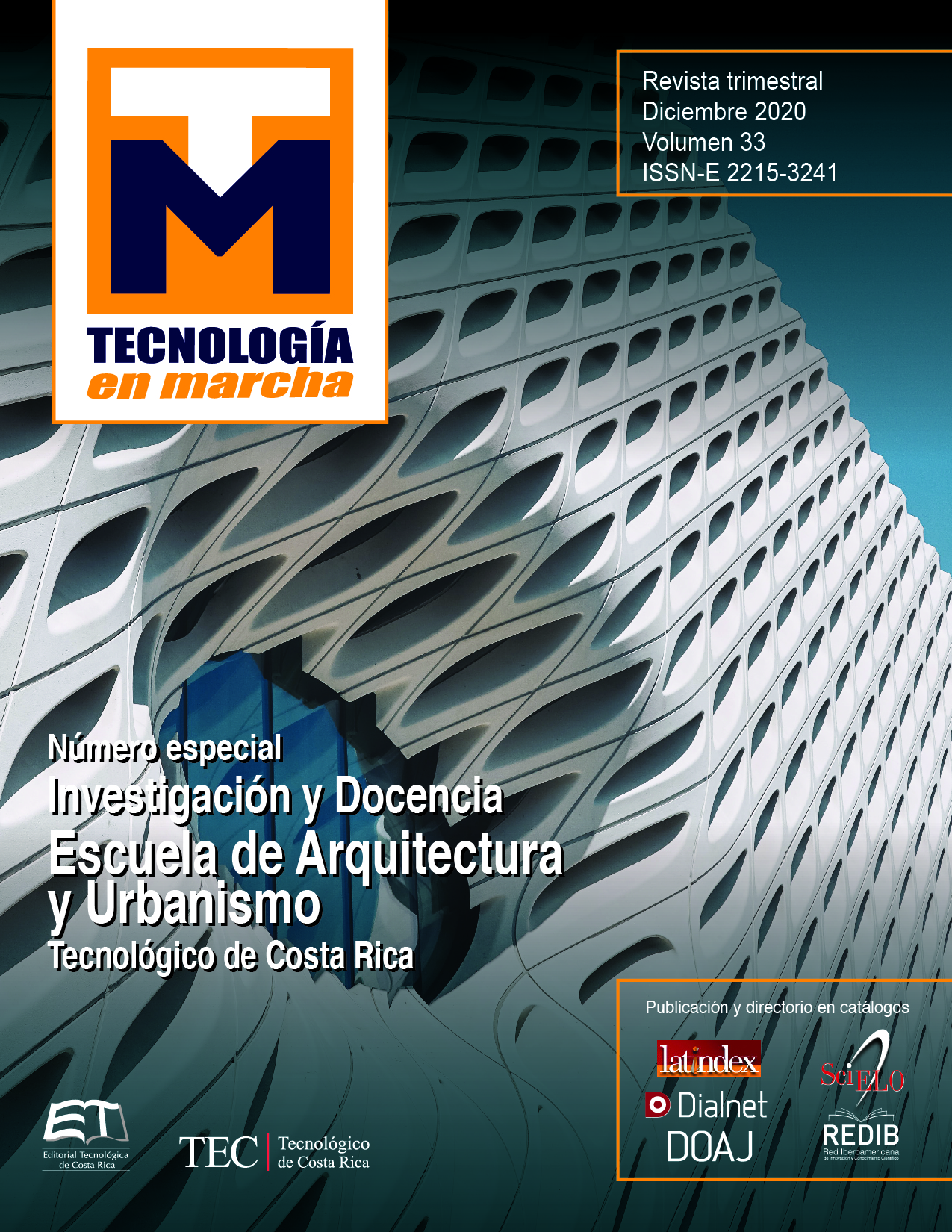Effect of light distribution in a scale model due to different light shelves
Main Article Content
Abstract
The aim of this experiment is to study the effect of light distribution in scale models of a real classroom due to different light shelves.
The construction of scale models of a classroom of the TEC´s Campus Tecnológico Local San José was carried out with taking the color of the ceiling as variable and maintaining its shape. For the cases of study, the performance of light shelves was analyzed to measure distribution of natural lighting coming from the window to the farthest spaces of the classroom, as well as their effectiveness as solar protection.
Three time slots were analyzed, morning, noon and afternoon, during December 2018 to January 2019, taking lighting measurements outside and within the scale model. The analyzed variables can be summarized as: color of the ceiling, shape of the light trays, and color applied to the walls and surfaces of the classroom.
From the results obtained, it is concluded that there are still large gaps in the understanding of how to achieve a uniform distribution of lighting inside a room, avoiding high visual contrasts, this is especially important in a classroom where there must be a priority in the visual comfort of its users. The specific use of flat light shelves showed effective both as a sunscreen element and to redirect light to spaces far away from the window.
Article Details

This work is licensed under a Creative Commons Attribution-NonCommercial-NoDerivatives 4.0 International License.
Los autores conservan los derechos de autor y ceden a la revista el derecho de la primera publicación y pueda editarlo, reproducirlo, distribuirlo, exhibirlo y comunicarlo en el país y en el extranjero mediante medios impresos y electrónicos. Asimismo, asumen el compromiso sobre cualquier litigio o reclamación relacionada con derechos de propiedad intelectual, exonerando de responsabilidad a la Editorial Tecnológica de Costa Rica. Además, se establece que los autores pueden realizar otros acuerdos contractuales independientes y adicionales para la distribución no exclusiva de la versión del artículo publicado en esta revista (p. ej., incluirlo en un repositorio institucional o publicarlo en un libro) siempre que indiquen claramente que el trabajo se publicó por primera vez en esta revista.
References
G. Maps, “Google Maps,” 14 Enero 2019. [Online]. Available: https://www.google.com/maps/d/viewer?mid=11X_5AoyPeeJBvWnFDnWO40fhYaQ&msa=0&ll=10.141931999999999%2C-83.75976600000001&z=8.
I. E. Gómez and W. Fernández, “Variación interanual de la temperatura en Costa Rica,” Tópicos Meteorológico y Oceanográficos, pp. 27-44, 1996.
DIRECCIÓN DE INFRAESTRUCTURA Y EQUIPAMIENTO EDUCATIVO, Ministerio de Educación Pública, “mep.go.cr,” Julio 2010. [Online]. Available: https://diee.mep.go.cr/sites/all/files/diee_mep_go_cr/preguntas-frecuentes/compendio_normas_edficios_para_educacion.pdf. [Accessed 2020].
N. Lasry, E. Mazur and J. Watkins, “Peer instruction: From Harvard to the two-year college.,” American journal of Physics, vol. 76, no. 11, pp. 1066-1069, 2008.
C. Coll, “Aprender y enseñar con las TIC: expectativas, realidad y potencialidades,” Boletín de la institución libre de enseñanza, vol. 72, no. 1, pp. 7-40, 2008.
G. Gómez and A. Villareal, “Cultura, Espacios para la Educación,” in Escala, Bogotá, 2004.
L. L. Fernandes, E. S. Lee and G. & Ward, “Lighting energy savings potential of split-pane electrochromic windows controlled for daylighting with visual comfort,” Energy and Buildings, vol. 61, pp. 8-20, 2013.
A. Pattini and C. Kirschbaum, “Evaluación subjetiva de aulas iluminadas con luz natural,” Avances en energías renovables y medio ambiente, 1998.
R. V. Ralegaonkar and R. Gupta, “Review of intelligent building construction: A passive solar architecture approach,” Renewable and Sustainable Energy Reviews, vol. 14, no. 8, pp. 2238-2242, 2010.
S. Hoses, G. San Juan, M. Melchiori and G. Viegas, “INCIDENCIA DE ESTRATEGIAS DE CONTROL SOLAR EN LA ILUMINACIÓN NATURAL DE AULAS ESCOLARES,” in ENTAC, Parana, 2002.
B. Arranz, E. Rodríguez-Ubinas, C. Bedoya-Frutos and S. Vega-Sánchez, “Evaluation of three solar and daylighting control systems based on Calumen II, Ecotect and radiance simulation programmes to obtain an energy efficient and healthy interior in the experimental building Prototype SD10,” Energy and Buildings, 83, ., pp. 225-236, 2014.
A. Ávila, “Sistema de iluminación integrada para un espacio de oficina en el trópico de Costa Rica. Tesis Doctoral,” Universidad Politécnica de Madrid, Madrid, 2010.
K. Steemers, “Daylighting design: Enhancing energy efficiency and visual quality,” Renewable Energy, pp. 950-958., 1994.
P. Littlefair, “Daylight prediction in atrium buildings.,” Solar energy, pp. 105-109, 2002.
L. O. Beltran, E. S. Lee and S. E. Selkowitz, “Advanced optical daylighting systems: light shelves and light pipes,” Journal of the illuminating engineering society, pp. 91-106, 1997.
U. Berardi and H. K. Anaraki, “Analysis of the impacts of light shelves on the useful daylight illuminance in office buildings in Toronto,” Energy Procedia, pp. 1793-1798, 2015.
J. I. R. Olabuénaga, Metodología de la investigación cualitativa, Universidad de Deusto: Gedisa, 2012.

